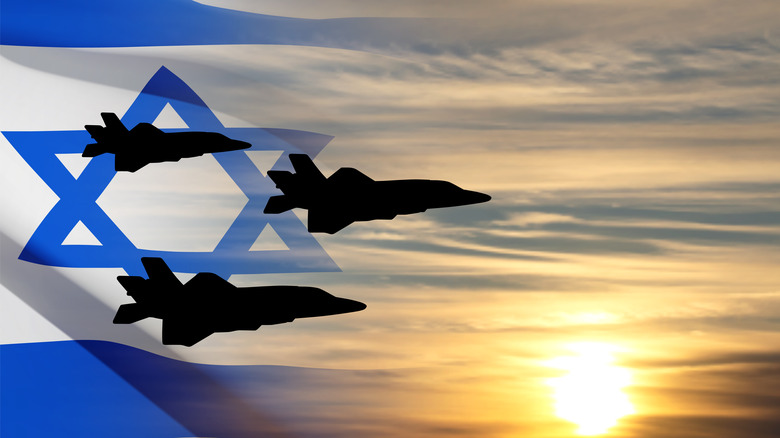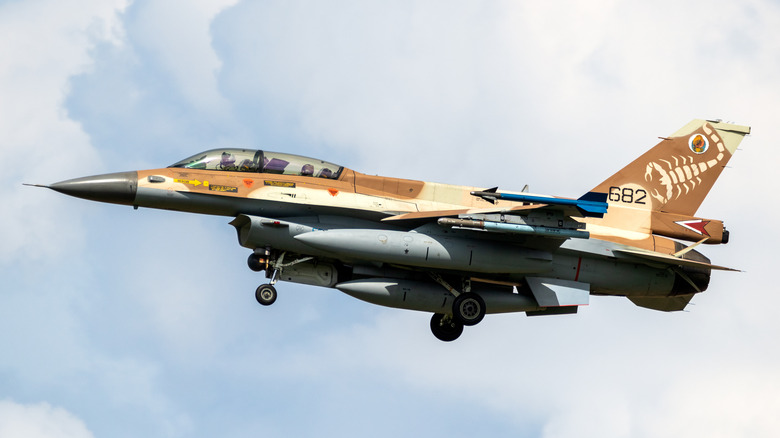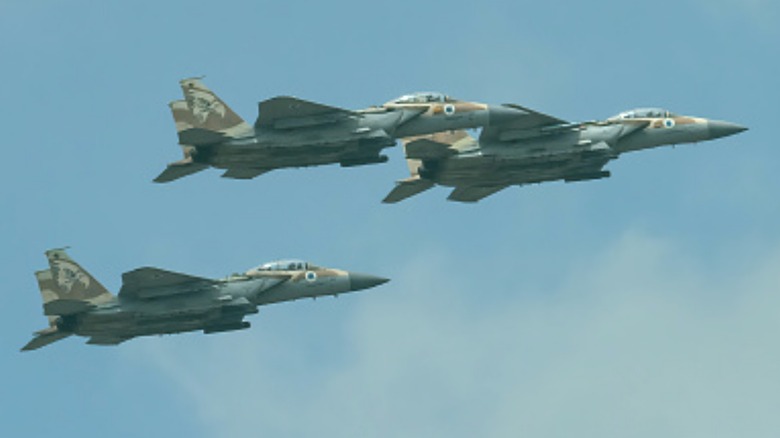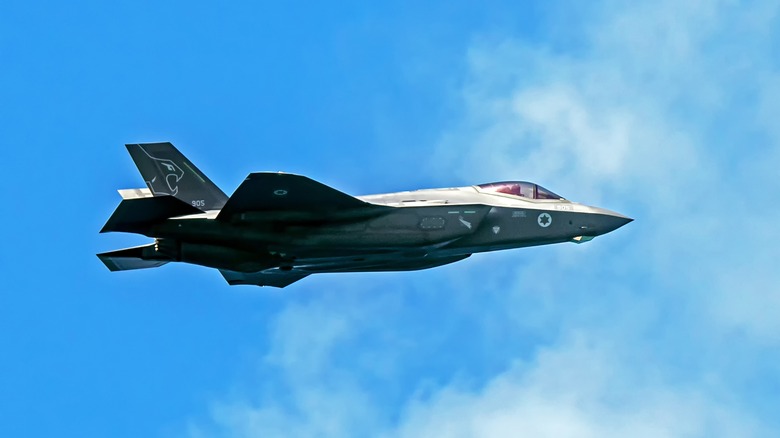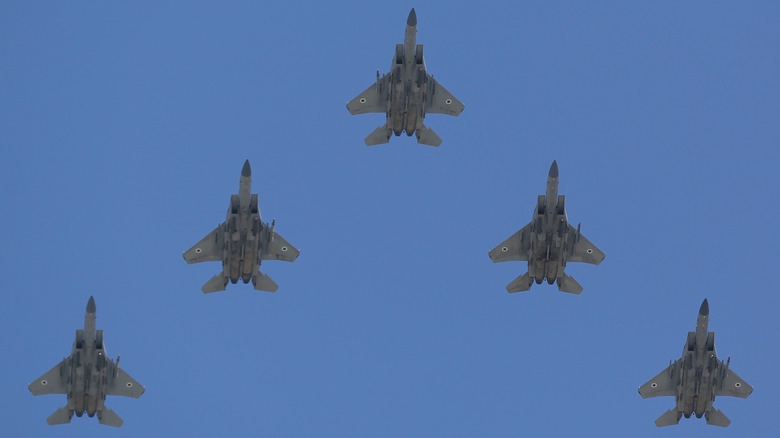How Many Fighter Jets Does Israel Have, And What Kinds Are They?
Israel wasted no time in establishing the Israeli Air Force (IAF), creating the organization on May 29, 1948 — two weeks after the nascent nation declared its independence. While it had several aircraft at the time, the modern IAF boasts a massive fleet of diverse combat aviation vehicles, including numerous fighters. Many of the IAF's fighters were purchased from partner nations, but the Israel Aerospace Industries developed several that are still in service.
While the IAF inventory includes numerous legacy aircraft like the American-made P-51D Mustang and others, its modern aircraft are the rivals of many nations around the world. Some of the more modern aircraft operated by the IAF include the F-14 Eagle, F-16 Fighting Falcon, and the U.S.-made F-35 Lightning II. With its acquisition of the F-35, Israel now possesses one of the most advanced fifth-generation fighters on the planet.
Those three are only a drop in the bucket of the IAF's fighter jets, which make up 43.2% of its total active aircraft. According to the World Directory of Modern Military Aircraft (WDMMA), as of August 2022, Israel maintains an active fleet of 581 aircraft — 251 of which are fighters. Most of Israel's fighters are multi-role aircraft, while some are air superiority and others are used primarily for strike operations. These are the main fighter jets the IAF has in service, though more are on the way.
The General Dynamics F-16 Fighting Falcon is Israel's primary fighter jet
According to the WDMMA, Israel operates several variants of the F-16. These include 102 F-16Is and 73 F-16Cs — totaling 175 F-16 aircraft. The F-16 is a fourth-generation fighter developed in the United States. The aircraft is a single-engine multirole fighter capable of fighter interception, air-to-ground bombing, and more. Since its introduction in 1979, the U.S. built over 4,600 F-16s, though they are no longer produced for domestic use.
Israel is one of the primary recipients of F-16s, which it uses for a variety of missions that are suitable for its capabilities. The F-16I Soufa is a modified variant of the F-16D, and the IAF modified the original aircraft to outfit its avionics and weapons systems needs of the organization. The F-16C Barak 2020 is another aircraft modified for use by the IAF, which received modernization upgrades suitable to modern fighter aircraft.
It should be noted that while the WDMMA lists only 175 F-16 variants operated by the IAF, other sources like Airforce Technology and Global Security indicate Israel has purchased a total of 362 F-16s, making it the largest fleet of the aircraft outside the U.S. The discrepancy may involve the difference between the total number of aircraft purchased vs. the total number of aircraft that remain operational. Despite the discrepancy from various sources, the IAF flies more F-16s than any other nation after the U.S.
The Boeing F-15I flies in support of the Israel-Hamas War
Israel's F-15I Ra'am, which is also known as "Thunder" in Israel, is a modified version of the Boeing F-15 Fighting Eagle. The notable difference between the two platforms is the size, as the F-15I can carry more weapons and fly further than its American counterpart. The two-seater aircraft also incorporates new weapons, electronic warfare and communications technology, and improved avionics, making it an ideal multirole aircraft for the IAF.
The original F-15 entered service in 1976, but despite its age, the fourth-generation fighter is more than capable of supporting Israel's operations. The IAF flies F-15Is in support of operations in Gaza, following the October 7, 2023 attack that sparked the Israel-Hamas War. The IAF previously flew F-15 Eagles, but ultimately replaced them with the F-15I, which is a more robust platform boasting increased range and armaments.
The IAF purchased 25 F-15Is from the United States in the mid-1990s, and continues to operate them to this day. While it stands to reason that they aren't as capable as the fifth-generation F-35, the F-15I boasts a superior combat range, enhancing Israel's air attack and defense capabilities. Of course, the IAF continues to procure modern aircraft, which led to the nation's purchase of the highly sought after F-25.
The Lockheed Martin F-35I Adir rounds out the IAF's offensive capabilities
In July 2023, the IAF and the U.S. launched a $3 billion deal to procure the F-35 Lightning II, bringing its fleet up from 25 aircraft to 75. The increase adds additional platforms to the existing inventory, derived from a 2010 deal. The F-35 is Israel's most advanced fighter, which the nation designates the F-35I Adir — which means "Mighty One" in Hebrew. The IAF received its first delivery of F-35s in 2016, and put them into active service the following year.
Israel was the first nation outside the nine-nation co-development group to procure the F-35, and it's the only Middle Eastern nation to fly the advanced aircraft. By all accounts, the F-35 is the most advanced fighter in the world, and the IAF has used them in its ongoing conflicts with neighboring belligerents. The IAF's F-35 Adir jets have had several combat successes, having first shot down two Iranian drones near Israeli airspace in 2021. Israel has also employed F-35s in its ongoing conflict with Hezbollah, and it was the first nation to use the sophisticated aircraft in combat.
Lockheed-Martin refused to modify the aircraft prior to delivery, so the IAF modified it via local defense contractors. The modified platform incorporates domestically produced electronic warfare systems, sensors, and countermeasures as well as a data link functionality best suited for IAF operations. These advancements help make the F-35I one of the most advanced combat aircraft ever employed, and a critical component in Israel's large fleet fighters.
Israel intends to add 50 more F-35Is to its arsenal
Israel's stock of fighter jets got a boost in June 2024 due to new arms sales and agreements between Israel and the United States. The Biden administration and Congress authorized the sale of numerous jets costing over $18 billion. The June sale includes 50 new F-15Is, but that's not all: an additional squadron of F-35Is is on its way to Israel, totaling $3 billion for 25 of the advanced aircraft. While these aircraft are earmarked for Israel, they won't arrive anytime soon.
It will likely take several years for the United States to fill the order, though it's unclear if the F-15s are new aircraft, or will be transferred from the existing U.S. inventory. For the F-35Is, the newly added jets will boost Israel's fleet to 75. The new F-35Is will make up a third squadron operated by the Israeli Air Force. Unlike typical arms sales, Israel will pay for the new aircraft via the U.S. military aid to Israel agreement, negating the need for a direct payment.
These latest arms sales were held up in Congress for several months before finally gaining approval. In addition to the jets, the U.S. will also sell Israel munitions for the new aircraft, including unspecified air-to-air missiles and Joint Direct Attack Munition kits, which are used to transform older so-called "dumb" bombs into smart, all-weather precision-guided munitions. Israel maintains the practice of modifying its acquired jets and will likely do so to the inbound aircraft, though it's unclear when these new fighters will arrive.
